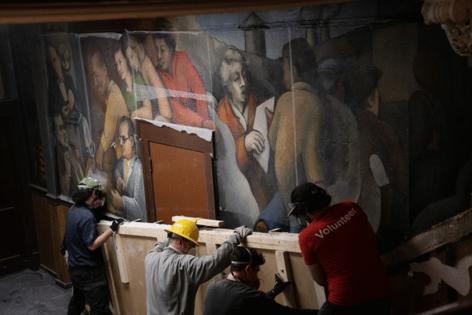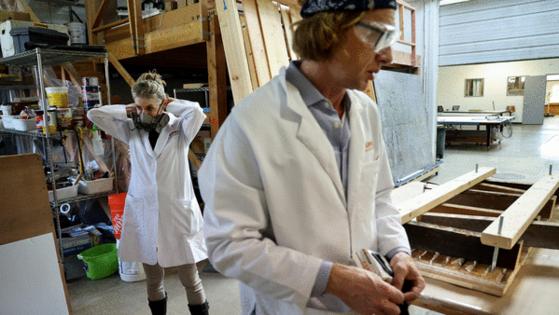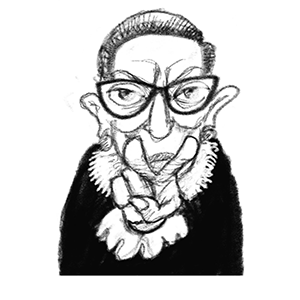One of Chicago's oldest public art pieces is saved, thanks to arts grant
Published in Lifestyles
CHICAGO -- Peter Schoenmann leaned over a rectangular hunk of plaster with a historic mural painted on it last week in Berwyn, Illinois. He began slowly shaving material off the backside of the hunk with a vibrating tool while his wife, who’s also an art conservator, positioned a vacuum near the blade and sucked up the debris.
The goal is to shave away the heavy plaster, which used to be part of a wall in a Near West Side union hall, until it’s about an eighth of an inch thick — so the mural can be hung in its new home.
Early in 2024, the United Electrical, Radio and Machine Workers of America union “moved heaven and earth” to rescue the mural — considered one of the oldest public art pieces in the Chicago area — from destruction, according to Carl Rosen, the general president of the union, which is also called the United Electrical Workers union.
Now, thanks to a $450,000 grant awarded by the Mellon Foundation, the public will be able to enjoy the mural once again.
“It was kind of a leap of faith by all of us in the art community, in the labor community, in the social justice community, everybody who was invested in preserving the mural to put the effort and put the funds in to get the mural off the walls — with the belief in ourselves and each other that we would find a way to get the funds (to conserve it),” he said.
The sprawling mural, which is titled “Solidarity” and narrates the history of industrial unionism, spanned the two lobbies and central staircase of the union’s meeting hall on South Ashland Avenue, which is being gutted and turned into apartments. A team of artists painted the vibrant work in the style of Diego Rivera between 1973 and 1974.
Chicago Public Art Group, the organization that received the Mellon Foundation grant, thinks works of art like “Solidarity” don’t simply enhance public spaces. The group believes they also foster community participation and investment.
“Community-engaged art helps instill the community with pride and ownership about their community,” Chantal Healey, the art group’s executive director, said in an email. “If a public art represents their voice, they are more likely to connect with it.”
After the conservation work is finished, most of the mural will be displayed prominently at the Near West Side office of the Chicago Teachers Union, which gets thousands of visitors and hosts numerous events every year, according to Healey.
Rosen said his union, which is headquartered in Pittsburgh and represents tens of thousands of workers nationwide, decided to sell the meeting hall a few years ago, partly because the union didn’t need as much office space after the pandemic. The sale to the apartment developer was finalized in March.
In the winter, with the gutting of the meeting hall’s interior — and thus the destruction of the mural — looming, the union partnered with Chicago Public Art Group, a nonprofit dedicated to enhancing public space and creating community engagement across the city, to rescue “Solidarity.”
By the middle of February, the organizations secured enough funding to remove “the most important parts” of the mural from the building, according to the union.
“Every additional dollar we can raise right now will help us save more of the mural,” Rosen said at the time, according to the union. In March, the Tribune reported the organizations had raised more than $200,000, enough to remove about 75% of the mural.
In the end, they pooled together enough resources to salvage maybe around 80% of the mural and get it into storage before the building redevelopment began, Healey said.
Because of the Mellon Foundation grant, the public art group was able to hire PARMA Conservation — the company which Schoenmann and his wife, Elizabeth Kendall, run — to conserve the mural.
Schoenmann and Kendall said their job is to make the chunky pieces of wall with the mural framable and displayable. They want their work to fade into the background of the work of the original artists.
According to Chicago Public Art Group, the conservation work is expected to be completed in late 2025.
Parts of the mural will eventually be sent in three different directions. Most of it will go to the Chicago Teachers Union office, where the United Electrical Workers union moved after selling its meeting hall.
Smaller sections will go to the Chicago office of In These Times, a progressive magazine, and to a United Electrical Workers hall in Erie, Pennsylvania.
Rosen said one of the union’s largest and most storied branches is in Erie. The mural section that is going to Pennsylvania depicts the union’s logo and its national officers from the 1940s through the 1960s.
For John Weber, one of the mural’s two lead artists, the most striking piece of the work depicts a suit-clad industrialist clutching a safe. In March, Weber, who was 81, said he was “very pleased” the mural was being saved from destruction.
“It’s a great honor that sections of it are going to be saved,” he said.
The two-story brick building where Weber and José Guerrero, the other lead artist, preserved labor history in hues of blue, red, yellow and green was originally built for the West End Woman’s Club in 1904. The western region of the United Electrical Workers union moved in 1948.
The meeting hall was once essential to the union’s operations. Local members would gather to vote and hold meetings. Though it primarily served as the western region headquarters, it also housed national staff based in Chicago.
While painting the mural, Weber and Guerrero juggled full-time jobs. Weber was a teacher, and Guerrero worked in a factory. It took over a year to complete. The pair spent months studying the inner workings of the union, hoping to capture the dogged spirit of the organization.
The artists were only paid $2,000 to cover the cost of paint, brushes and scaffolding.
Weber said the contrast between how much money it took to make the mural and how much it was taking to save it was “mind-blowing.”
©2024 Chicago Tribune. Visit chicagotribune.com. Distributed by Tribune Content Agency, LLC. ©2024 Chicago Tribune. Visit at chicagotribune.com. Distributed by Tribune Content Agency, LLC.



























Comments